 Per un Master of Wine il concetto di Terroir è un pò come la Forza in Star Wars ovvero un sottile fluido che attraverso la terra arriva e permane nel vino e ogni tentativo di degustazione e di creazione del vino è riconducibile a leggere e far ritrovare in un bicchiere il concetto appunto di terroir. Terroir che è, nelle parole appunto di David Gleave, fondatore di Liberty Wine, udite giovedì 12 e venerdì 13 (alla faccia delle superstizioni) al Croce di Malta a Montecatini, “Soil, Climate, Aspect, Luminosity, Ventillation, Diurnal variation, Grape variety” ma anche il modo con cui l’uomo interviene su questo ovvero “Temperature, Cuvaison, Oak, Cleanliness, Bottling“. Da questo “statement” abbiamo discusso per un pò su come da questo assioma si possono derivare la quasi totalità degli aspetti che caratterizzano un vino e la sua descrizione. Si può essere più o meno d’accordo su questa vision ma vi assicuro che ieri, soprattutto attraverso le numerose degustazioni alla cieca effettuate (qui tutte le foto dei vini) il concetto è risultato davvero chiaro, anzi “bright” (cristallino?) .
Per un Master of Wine il concetto di Terroir è un pò come la Forza in Star Wars ovvero un sottile fluido che attraverso la terra arriva e permane nel vino e ogni tentativo di degustazione e di creazione del vino è riconducibile a leggere e far ritrovare in un bicchiere il concetto appunto di terroir. Terroir che è, nelle parole appunto di David Gleave, fondatore di Liberty Wine, udite giovedì 12 e venerdì 13 (alla faccia delle superstizioni) al Croce di Malta a Montecatini, “Soil, Climate, Aspect, Luminosity, Ventillation, Diurnal variation, Grape variety” ma anche il modo con cui l’uomo interviene su questo ovvero “Temperature, Cuvaison, Oak, Cleanliness, Bottling“. Da questo “statement” abbiamo discusso per un pò su come da questo assioma si possono derivare la quasi totalità degli aspetti che caratterizzano un vino e la sua descrizione. Si può essere più o meno d’accordo su questa vision ma vi assicuro che ieri, soprattutto attraverso le numerose degustazioni alla cieca effettuate (qui tutte le foto dei vini) il concetto è risultato davvero chiaro, anzi “bright” (cristallino?) .
Molto interessante anche l’illustrazione della scheda di degustazione dei “master” con alcune voci da noi poco considerate come la stima del prezzo, il carattere dell’acidità e la valutazione della qualità del tannino, davvero utile.
 Ieri con Cristiano Cini, vicecampione nazionale, altri sommelier e membri della GEN nazionale (tra cui Antonello Maietta) e delegati da tutta Italia (Isole e Sud Italia compresi), abbiamo affrontato la degustazione bendata di una serie di vini che differivano praticamente solo per il terroir appunto, a parità di pratica enologica e vitigno. E così ci siamo trovati davanti a due Sauvignon Blanc, uno NeoZelandese della Delta Wines, e uno del nostro Collio, ovvero quello di Sgubin e le note di profumi e le sensazioni “on the palate” non potevano essere più diverse. Però, wow, ero riuscito a beccarli entrambi come provenienza, addirittura indicando proprio Collio per l’Italiano e Marlborough per il neozelandese.
Ieri con Cristiano Cini, vicecampione nazionale, altri sommelier e membri della GEN nazionale (tra cui Antonello Maietta) e delegati da tutta Italia (Isole e Sud Italia compresi), abbiamo affrontato la degustazione bendata di una serie di vini che differivano praticamente solo per il terroir appunto, a parità di pratica enologica e vitigno. E così ci siamo trovati davanti a due Sauvignon Blanc, uno NeoZelandese della Delta Wines, e uno del nostro Collio, ovvero quello di Sgubin e le note di profumi e le sensazioni “on the palate” non potevano essere più diverse. Però, wow, ero riuscito a beccarli entrambi come provenienza, addirittura indicando proprio Collio per l’Italiano e Marlborough per il neozelandese.
 Stesso discorso per il confronto sul Syrah, stavolta Australia Adelaide Hills Shaw Smith “contro” il nostro illustre Cortona Tenimenti d’Alessandro Il Bosco. Anche qui, a dispetto dei pregiudizi (miei compresi!) che vedono gli Australiani densi marmellatosi e carichi vengono sfatati da un croccantissimo e fresco syrah (anzi Shiraz) pepato bianco con un colore incantevole e un palato delicato e fresco, davvero accattivante. Al cospetto di questo Australiano, il pur notevole “Il Bosco” arrancava un pò e pareva l’australiano di turno…tant’è che quasi nessuno lo aveva votato come Italiano o europeo. (Ovviamente io avevo votato il primo come Syrah sudamericano e il secondo come un Barossa Valley).
Stesso discorso per il confronto sul Syrah, stavolta Australia Adelaide Hills Shaw Smith “contro” il nostro illustre Cortona Tenimenti d’Alessandro Il Bosco. Anche qui, a dispetto dei pregiudizi (miei compresi!) che vedono gli Australiani densi marmellatosi e carichi vengono sfatati da un croccantissimo e fresco syrah (anzi Shiraz) pepato bianco con un colore incantevole e un palato delicato e fresco, davvero accattivante. Al cospetto di questo Australiano, il pur notevole “Il Bosco” arrancava un pò e pareva l’australiano di turno…tant’è che quasi nessuno lo aveva votato come Italiano o europeo. (Ovviamente io avevo votato il primo come Syrah sudamericano e il secondo come un Barossa Valley).
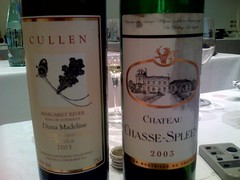 Ultima degustazione della mattinata e tocca a due blend a maggioranza Cabernet con Chasse Spleen 2003 contro (di nuovo) Australia, un interessantissimo Culeen Diana Madelein 2004 che ha surclassato l’illustre bordolese con una eleganza di frutto e spezia quasi inaudite (per me) in un vino australiano a base cabernet. Certo che la Margaret River è ben poco conosciuta ma merita davvero di essere ri-scoperta da molti IMHO. Io avevo optato per un Cabernet Sangiovese sullo Chasse Spleen (tipo Tignanello per dirla tutta) e per un blend bordolese cileno per il primo (stile Don Melchor di Concha y Toro).
Ultima degustazione della mattinata e tocca a due blend a maggioranza Cabernet con Chasse Spleen 2003 contro (di nuovo) Australia, un interessantissimo Culeen Diana Madelein 2004 che ha surclassato l’illustre bordolese con una eleganza di frutto e spezia quasi inaudite (per me) in un vino australiano a base cabernet. Certo che la Margaret River è ben poco conosciuta ma merita davvero di essere ri-scoperta da molti IMHO. Io avevo optato per un Cabernet Sangiovese sullo Chasse Spleen (tipo Tignanello per dirla tutta) e per un blend bordolese cileno per il primo (stile Don Melchor di Concha y Toro).
 Altre prove nel pomeriggio, ancora più interesanti con 3 “Chards” immediatamente riconosciuti come tali dalla platea ma quando siamo andati a cercare di individuare i terroir di provenienza…sul Cote de Beaune quasi tutti sicuri di essere nel Nuovo Mondo, un sacco di Chablis per il Sanct Valentin (l’unico che invece ho riconosciuto al volo come altoatesino) e ancora Francia per il notevole HellFire Bay Australiano. Insomma, vatti a fidare di un “innocuo” Chardonnay!
Altre prove nel pomeriggio, ancora più interesanti con 3 “Chards” immediatamente riconosciuti come tali dalla platea ma quando siamo andati a cercare di individuare i terroir di provenienza…sul Cote de Beaune quasi tutti sicuri di essere nel Nuovo Mondo, un sacco di Chablis per il Sanct Valentin (l’unico che invece ho riconosciuto al volo come altoatesino) e ancora Francia per il notevole HellFire Bay Australiano. Insomma, vatti a fidare di un “innocuo” Chardonnay!
 Gran finale con la chimera di ogni terroirista che si rispetti ovvero il Pinot Noir, la morte nera di ogni degustatore sedicente esperto, che ha messo affiancati Alto Adige, Martinborough e Borgogna. E qui nonostante abbia da poco finito di bere 50 Pinot Neri altoatesini e neanche un mese fa proprio sua maestà Ata Rangi (ma il 2002) ecco che riesco a riconoscere solo lo Chambolle Musigny 2006 di Boisset mentre sparo su California per il Mazzon di Gottardi e un bel Chambertin Premier Cru per il neozelandese. Imparo quindi che il profumo tipico della spezia altoatesina è davvero riconoscibile e che la felce di sottobosco è tipica dei Pinot Noir della Nuova Zelanda
Gran finale con la chimera di ogni terroirista che si rispetti ovvero il Pinot Noir, la morte nera di ogni degustatore sedicente esperto, che ha messo affiancati Alto Adige, Martinborough e Borgogna. E qui nonostante abbia da poco finito di bere 50 Pinot Neri altoatesini e neanche un mese fa proprio sua maestà Ata Rangi (ma il 2002) ecco che riesco a riconoscere solo lo Chambolle Musigny 2006 di Boisset mentre sparo su California per il Mazzon di Gottardi e un bel Chambertin Premier Cru per il neozelandese. Imparo quindi che il profumo tipico della spezia altoatesina è davvero riconoscibile e che la felce di sottobosco è tipica dei Pinot Noir della Nuova Zelanda  (del resto basterebbe guardare la maglietta degli All Blacks!). Su Chambolle Musigny mi ha aiutato una recente degu dalla Heres che ne aveva portato alcuni campioni a Prato ma direi che su Pinot Neri così giovani non è mai facile indovinare la provenienza.
(del resto basterebbe guardare la maglietta degli All Blacks!). Su Chambolle Musigny mi ha aiutato una recente degu dalla Heres che ne aveva portato alcuni campioni a Prato ma direi che su Pinot Neri così giovani non è mai facile indovinare la provenienza.
Conclusione di giornata consolante sulle parole di David che ci assicura che il riconoscimento alla cieca di un vino è “based on luck more than skill” e che in realtà per professionisti come i Master of Wine (e anche direi i sommelier) è molto più importante sape attribuire un prezzo ai vini piuttosto che dire di che vino si tratti.
Complimenti all’AIS per la bella e interessante iniziativa e per avermi invitato, e a Roberto Bellini per l’ospitalità in quel di Montecatini, sempre di alto livello.
A quando la prossima? mi devo rifare subito, quel Sangiovese nello Chasse Spleen grida vendetta!!!
 Nonostante le 150 persone presenti non è stato comunque possibile accogliere tutte le richieste di presenza a questa (spero) interessante degustazione che ha messo in evidenza il comportamento del Sangiovese nel mondo e le sue reazioni ai diversi terroir e tecniche di vinificazione. Stefano si è occupato della parte tecnica mentre a me l’onore di curare la componente edonistica. Degustazione faticosa (soprattutto per i ragazzi della Delegazione di Firenze in servizio, bravissimi!) ma stimolante anche per chi è abituato tutti i giorni ad annusare questo vitigno perchè comunque non smette mai di stupire per vivacità di comportamento e carattere che viene fuori nei momenti più inaspettati…
Nonostante le 150 persone presenti non è stato comunque possibile accogliere tutte le richieste di presenza a questa (spero) interessante degustazione che ha messo in evidenza il comportamento del Sangiovese nel mondo e le sue reazioni ai diversi terroir e tecniche di vinificazione. Stefano si è occupato della parte tecnica mentre a me l’onore di curare la componente edonistica. Degustazione faticosa (soprattutto per i ragazzi della Delegazione di Firenze in servizio, bravissimi!) ma stimolante anche per chi è abituato tutti i giorni ad annusare questo vitigno perchè comunque non smette mai di stupire per vivacità di comportamento e carattere che viene fuori nei momenti più inaspettati…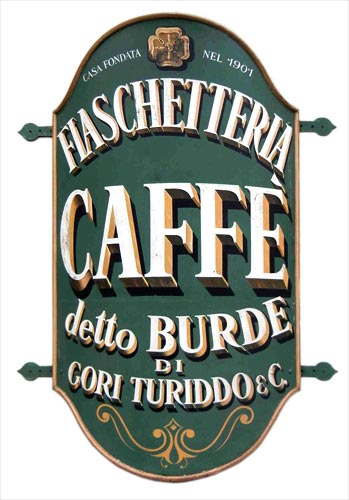
 Secondo il Cav. Rivella, ormai lo si sa, sarebbe il
Secondo il Cav. Rivella, ormai lo si sa, sarebbe il  Per un
Per un  Ieri con Cristiano Cini, vicecampione nazionale, altri sommelier e membri della GEN nazionale (tra cui Antonello Maietta) e delegati da tutta Italia (Isole e Sud Italia compresi), abbiamo affrontato la degustazione bendata di una serie di vini che differivano praticamente solo per il terroir appunto, a parità di pratica enologica e vitigno. E così ci siamo trovati davanti a due Sauvignon Blanc, uno NeoZelandese della
Ieri con Cristiano Cini, vicecampione nazionale, altri sommelier e membri della GEN nazionale (tra cui Antonello Maietta) e delegati da tutta Italia (Isole e Sud Italia compresi), abbiamo affrontato la degustazione bendata di una serie di vini che differivano praticamente solo per il terroir appunto, a parità di pratica enologica e vitigno. E così ci siamo trovati davanti a due Sauvignon Blanc, uno NeoZelandese della Stesso discorso per il confronto sul Syrah, stavolta Australia Adelaide Hills Shaw Smith “contro” il nostro illustre Cortona Tenimenti d’Alessandro Il Bosco. Anche qui, a dispetto dei pregiudizi (miei compresi!) che vedono gli Australiani densi marmellatosi e carichi vengono sfatati da un croccantissimo e fresco syrah (anzi Shiraz) pepato bianco con un colore incantevole e un palato delicato e fresco, davvero accattivante. Al cospetto di questo Australiano, il pur notevole “Il Bosco” arrancava un pò e pareva l’australiano di turno…tant’è che quasi nessuno lo aveva votato come Italiano o europeo. (Ovviamente io avevo votato il primo come Syrah sudamericano e il secondo come un Barossa Valley).
Stesso discorso per il confronto sul Syrah, stavolta Australia Adelaide Hills Shaw Smith “contro” il nostro illustre Cortona Tenimenti d’Alessandro Il Bosco. Anche qui, a dispetto dei pregiudizi (miei compresi!) che vedono gli Australiani densi marmellatosi e carichi vengono sfatati da un croccantissimo e fresco syrah (anzi Shiraz) pepato bianco con un colore incantevole e un palato delicato e fresco, davvero accattivante. Al cospetto di questo Australiano, il pur notevole “Il Bosco” arrancava un pò e pareva l’australiano di turno…tant’è che quasi nessuno lo aveva votato come Italiano o europeo. (Ovviamente io avevo votato il primo come Syrah sudamericano e il secondo come un Barossa Valley). Ultima degustazione della mattinata e tocca a due blend a maggioranza Cabernet con Chasse Spleen 2003 contro (di nuovo) Australia, un interessantissimo
Ultima degustazione della mattinata e tocca a due blend a maggioranza Cabernet con Chasse Spleen 2003 contro (di nuovo) Australia, un interessantissimo  Altre prove nel pomeriggio, ancora più interesanti con 3 “Chards” immediatamente riconosciuti come tali dalla platea ma quando siamo andati a cercare di individuare i terroir di provenienza…sul Cote de Beaune quasi tutti sicuri di essere nel Nuovo Mondo, un sacco di Chablis per il Sanct Valentin (l’unico che invece ho riconosciuto al volo come altoatesino) e ancora Francia per il notevole HellFire Bay Australiano. Insomma, vatti a fidare di un “innocuo” Chardonnay!
Altre prove nel pomeriggio, ancora più interesanti con 3 “Chards” immediatamente riconosciuti come tali dalla platea ma quando siamo andati a cercare di individuare i terroir di provenienza…sul Cote de Beaune quasi tutti sicuri di essere nel Nuovo Mondo, un sacco di Chablis per il Sanct Valentin (l’unico che invece ho riconosciuto al volo come altoatesino) e ancora Francia per il notevole HellFire Bay Australiano. Insomma, vatti a fidare di un “innocuo” Chardonnay! Gran finale con la chimera di ogni terroirista che si rispetti ovvero il Pinot Noir, la morte nera di ogni degustatore sedicente esperto, che ha messo affiancati Alto Adige, Martinborough e Borgogna. E qui nonostante abbia
Gran finale con la chimera di ogni terroirista che si rispetti ovvero il Pinot Noir, la morte nera di ogni degustatore sedicente esperto, che ha messo affiancati Alto Adige, Martinborough e Borgogna. E qui nonostante abbia  (del resto basterebbe guardare la maglietta degli All Blacks!). Su Chambolle Musigny mi ha aiutato una recente degu dalla Heres che ne aveva portato alcuni campioni a Prato ma direi che su Pinot Neri così giovani non è mai facile indovinare la provenienza.
(del resto basterebbe guardare la maglietta degli All Blacks!). Su Chambolle Musigny mi ha aiutato una recente degu dalla Heres che ne aveva portato alcuni campioni a Prato ma direi che su Pinot Neri così giovani non è mai facile indovinare la provenienza.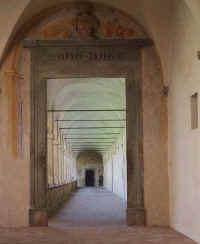
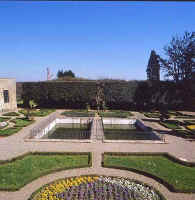
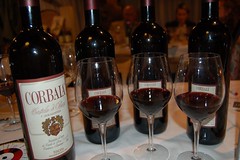 Some months ago, Wine Spectator said that this supertuscan was only “Full-bodied, soft and round. In-your-face style. Slightly overdone this year. Best after 2005.”
Some months ago, Wine Spectator said that this supertuscan was only “Full-bodied, soft and round. In-your-face style. Slightly overdone this year. Best after 2005.”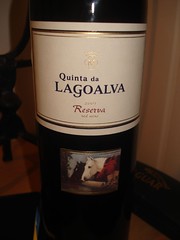

 Not counting for this WBW I managed to taste a “infamous” VinhoVerde, from Vidigal, made only of Alvarinho and I must admit that was really fresh (almost carbonated) and with a pleasant taste of apple and citrus. Here too, not bad at all for a 4,5 euro wine.
Not counting for this WBW I managed to taste a “infamous” VinhoVerde, from Vidigal, made only of Alvarinho and I must admit that was really fresh (almost carbonated) and with a pleasant taste of apple and citrus. Here too, not bad at all for a 4,5 euro wine.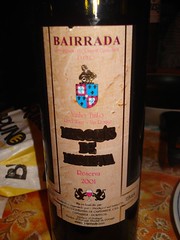 . This time I found a stranger wine, lot less international than the other with an aroma ten times less for intensity. But the lack of aroma was well balanced with a wonderful and full taste of good wine with a strong body, well balanced tannins and a fruity, yet simple, finish. I found the Bairrada maybe a little bit less complex at the nose but a more honest wine in the palate. Just about the different you can taste between a good old school Chianti and an internatial Chianti made of Sangiovese and Merlot (that I HATE!).
. This time I found a stranger wine, lot less international than the other with an aroma ten times less for intensity. But the lack of aroma was well balanced with a wonderful and full taste of good wine with a strong body, well balanced tannins and a fruity, yet simple, finish. I found the Bairrada maybe a little bit less complex at the nose but a more honest wine in the palate. Just about the different you can taste between a good old school Chianti and an internatial Chianti made of Sangiovese and Merlot (that I HATE!).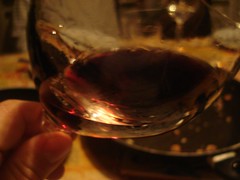
 Here it is, our 2004 champion, the highest italian wine in the Wine Spectator 2006 Chart of the top 100 wines. In that ranking the 2003 was rated 95 points and reached number 5 in the rank. This 2004 for us is even better with powerful and seductive aromas of fruit and spice, tons more elegant than the 2003 counterpart.
Here it is, our 2004 champion, the highest italian wine in the Wine Spectator 2006 Chart of the top 100 wines. In that ranking the 2003 was rated 95 points and reached number 5 in the rank. This 2004 for us is even better with powerful and seductive aromas of fruit and spice, tons more elegant than the 2003 counterpart.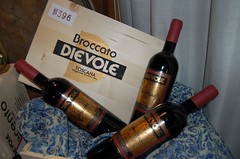 Another Supertuscan, this time made with Sangiovese Cabernet Merlot and a little bit of Petit Verdot. But this time we have a light and enjoying wine, not too concentrated and simple to drink and to make food pairings with.
Another Supertuscan, this time made with Sangiovese Cabernet Merlot and a little bit of Petit Verdot. But this time we have a light and enjoying wine, not too concentrated and simple to drink and to make food pairings with. 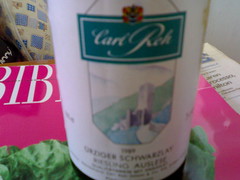 This started as a joke from my wife’s parents…but it ended like a good and formativa tasting! It’s always difficult to find good and old
This started as a joke from my wife’s parents…but it ended like a good and formativa tasting! It’s always difficult to find good and old 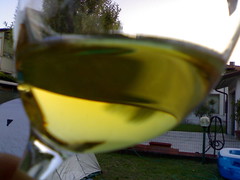
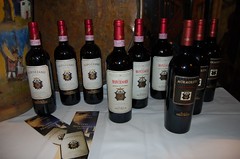 Here we are with a “typical” Cab-based supertuscan, this time coming from an ancient DOC like Chianti Rufina. Here Frescobaldi produces the world famous Castello di Nipozzano Riserva and the cru Montesodi based mainly on Sangiovese. But the terroir here has proven to be good for another grape variety like the Cabernet Sauvignon, here as its best yet a little bit too young…(will be perfect in 2-3 years)
Here we are with a “typical” Cab-based supertuscan, this time coming from an ancient DOC like Chianti Rufina. Here Frescobaldi produces the world famous Castello di Nipozzano Riserva and the cru Montesodi based mainly on Sangiovese. But the terroir here has proven to be good for another grape variety like the Cabernet Sauvignon, here as its best yet a little bit too young…(will be perfect in 2-3 years)